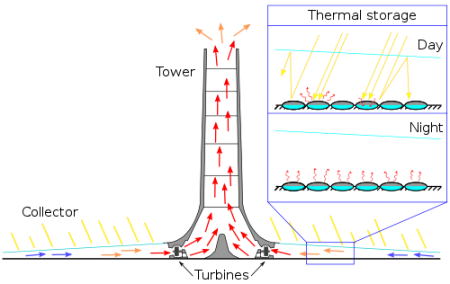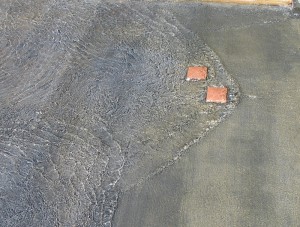
Discovery Channel has a nice video on using a large tower, set at the center of a large greenhouse in the dessert, to generate thermal convection to power electrical turbines.
Middle and High School … from a Montessori Point of View

Discovery Channel has a nice video on using a large tower, set at the center of a large greenhouse in the dessert, to generate thermal convection to power electrical turbines.
How do solar cells (photovoltaic cells) work? There are very simple explanations, but you can probably find a video with any level of complexity you might want.
This video from the U.S. Department of Energy is fairly general and makes a nice introduction:
This video adds some useful detail.
For even more detail, NASA’s page on photovoltaics is very good, and Scientific American has a neat little interview with Paul Alivisatos that goes into the parallel between photovoltaic technology and photosynthesis.
The UK Science Museum has a set of very simple videos describing how different sources of energy are created and harnessed. They are very simplified but perhaps useful introductions to how things like solar cells work; how oil and natural gas form; what is fusion and how it might be harnessed; how tidal power works etc.
Apparently, 8% of human genes have been spliced in by viruses.
The assimilation of viral sequences into the host genome is a process referred to as endogenization. This occurs when viral DNA integrates into a chromosome of reproductive cells and is subsequently passed from parent to offspring. – University of Texas at Arlington (2010)

The Memphis to Charleston line was the only railroad that linked the East Coast of the Confederacy to the fertile Mississippi River Valley. At a time when the fastest way to move troops, supplies and commerce was by river or rail, the Memphis and Charleston railroad was essential (this was well noted in Robert Black’s “The Railroads of the Confederacy”). Cutting the railroad was an important objective of the Union. Cutting it at Corinth Mississippi would also cut the Mobile and Ohio Railroad line which linked the north and south of the Confederacy. Thus the Battle of Shiloh, where the Union could disembark its armies using the Tennessee River, and soon after, the Battle of Corinth.
The Civil War Interpretive Center in Corinth (this is also a good reference) does a nice job of presenting the details of the battles for the town, and their video presentation, with different images projected on multiple screens in a circular room was quite good (though there was a lot of information and you did not know quite which screen to focus on, so some students had trouble keeping track of it all).

The most interesting part of the center is the Stream of American History which is a wonderful place to learn about metaphors. The stream starts with a fountain that overflows through 13 notches cut in the rim of the basin into a shallow water course that gradually widens as more states are added to the U.S. In the first reach of the stream there are impediments in the paved stream bed that create turbulence, harbingers of the war to come (they create nice standing waves which is an additional point in their benefit).

When the stream gets to its main focus, the civil war, large granitic blocks, cut into prisms and labeled with the names of the battles, break the stream into two before it finally merges again as it reaches the reflecting pool.
I threw my students at the Stream without telling them what it was. The only hint I gave was that it was a “large metaphor”. There were enough clues that they could figure it out. They wandered around it individually, with their pencils and notepaper for 15 minutes (I required that they write down their interpretation, then we got them together to pool their thoughts.
The stream is a very nice puzzle, and the National Park Service has a good key (pdf). It was a good way to end our immersion trip, and it gave the students something to think about on the long drive home.
[googleMap name=”Corinth Civil War Interpretive Center” width=”400″ height=”350″ mapzoom=”4″ mousewheel=”false” directions_to=”false”]501 West Linden Street, Corinth, MS[/googleMap]
The mind tend to wander when working at repetitive tasks that don’t require much brain processing. So the brain just switches over to thinking about long-term things. There is even a specific part of the brain, called the “default network” that starts up when we zone-out. That, at least, is what I summarize from looking at some neuroscience research by Malia Mason and others (2007) on wandering minds.
What’s interesting is that the default network tends to be used for “certain kinds of self-referential thinking, such as reflecting on personal experiences or picturing yourself in the future” (Zimmer, 2010). That means introspection. Introspection is the point of Personal World, so it follows that we should want our students’ minds to wander during Personal World.
So how do we design the Personal World time and environment to encourage daydreaming? Repetitive tasks aid mind-wandering, as will anything that is rote that does not require acute cognitive focus. Raking the garden, doodling should be encouraged, in fact, anything that encourages boredom.
I would think also, that reducing the cognitive load would also be beneficial, which might also mean no music. Yet music helps isolate the individual, particularly when they’re using ear buds. Perhaps quiet, “boring” sounds would be best, coming a shared radio so students can’t choose to listen to something else. Of course, if you’re listening to the music on your mp3 player then you tend to tune out the songs anyway so maybe it all falls out in the wash.
Of course this could all be malarkey, based as it is on a single study, so I’ll end with the words of caution that coms at the end of the article:
Although the thoughts the mind produces when wandering are at times useful, such instances do not prove that that the mind wanders because these thoughts are adaptive; on the contrary the mind may wander simply because it can. – Mason et al., 2007.
Focused work. We like to see our students focused on their work and we give them long blocks of time to do so. It is hard, however, for anyone to stay on task for two hours straight. You have to allow for a certain amount of mind wandering and daydreaming. What a lot of neurologic research is uncovering is that zoning-out is an essential part of putting the pieces together and helps with learning.
When we are no longer even aware that our minds are wandering, we may be able to think most deeply about the big picture. – Zimmer (2010)

While we sleep the brain assembles information into coherent patterns, helping us learn and process emotions. Carl Zimmer has an article in Discover Magazine on how unfocused daydreaming accomplishes the same thing.
“It’s going to be a constant question for us as a society and for the military whether or not, as they become more game-like, that creates an effect that makes it easier to kill people in a way that you might not want to make it easier to kill people.” – Clive Thompson on On The Media (2010)
On The Media had one of the most though provoking pieces this weekend that I have ever heard. It was based on the video footage of the tragic killing of two Reuters journalists in Baghdad, and the wounding of two small children in a van that came to rescue the injured, by a US helicopter gunship. The program dealt with the tragedy itself, the question of war crimes and the propriety of Wikileaks in publishing the video.
They also addressed the marked similarities between the video footage and scenes in modern video games. What was most interesting was that the interviewee, Clive Thompson, argued not that video games were becoming too much like war and desensitizing players, but that war is becoming too much like video games.
It’s been generally acknowledged that the further away the person is, the less you can see them, the more they’re just a blip on the screen, the easier it is to pull the trigger. – Clive Thompson on On The Media (2010)
Audio of the piece called “Virtual War” is below: